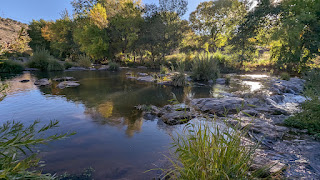**Authentically Human! Not Written by AI**
 |
| My 12x9 demonstration for the workshop. It's a bit abstract, but everyone liked the way I pulled disparate elements together from different references. |
As I write, I'm currently in Sedona, Arizona, having just left Art Fest, one of the "Makers Festivals" put on by my publisher, Golden Peak Media. In Mesa, I taught an outdoor-study-to-studio workshop. Interestingly, we didn't do the "outdoor" part, as it was just a one-day class, but I had students gather plein air references—color studies, pencil drawings, photographs—prior to the class. (I provided them with plenty of instruction well in advance of our meeting.) It was a good class, and I think everyone came away with the tools they need to bring their paintings to a higher level.
My philosophy is this. Plein air painting is for responding to the landscape before you; the studio is the place to reflect upon what you have done and to make it better. In the studio, we have full control of the environment, plus plenty of time, as well as all the tools, to take care of the things we might not have been able to take care of in the field. Personally, I've found my work much improved—and my satisfaction level much increased—by taking my plein air references into the studio where I can create a perhaps larger and certainly more-considered piece.
 |
| Color studies for the above piece. |
And now I'm in Sedona. If you've been following my blog over the years, you'll remember that I was an Invited Artist to the Sedona Plein Air Festival for many years. (A quick check of my records shows I attended every year from 2006 to 2011, and then again from 2014-2016, a total of nine years.) I have very fond memories of painting with excellent artists, many of whom have become good if not close friends. Coincidentally, this weekend marks the end of this year's festival, the 19th, and I was able to go into town to see the art and to meet the new crop of artists. The work is good, and I hope they have lots of sales.
 |
| Artists' games at the Sedona Arts Center, part of the Sedona Plein Air Festival. It was like "tag team painting." |
(By the way, I lived near Sedona for several years. It was also good to revisit some old hikes.)
Did I feel nostalgic and, perhaps, sad at not being part of this year's event? Not really. I've paid my dues, enjoyed my time, and it was good to wander through the galleries and among the artists under the guise of anonymity. Still, I might do the event again—so stay tuned.
 |
| A good fortune for an artist. Received at the end of a fine meal at one of our favorite Sedona restaurants. |
 |
| One of my secret spots along Oak Creek, not far from where I used to live. |


























